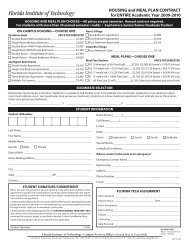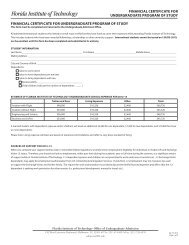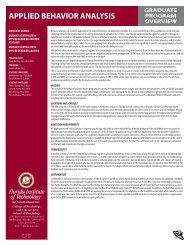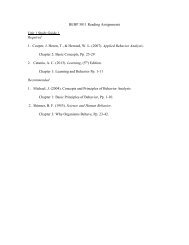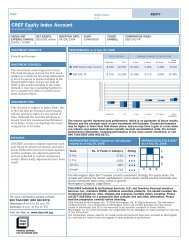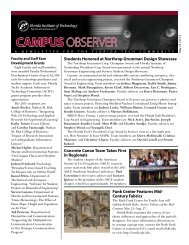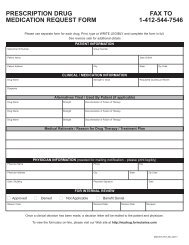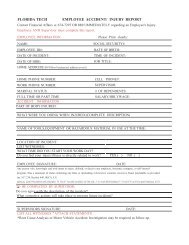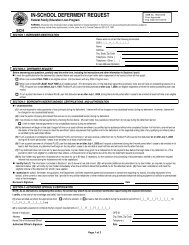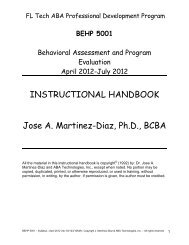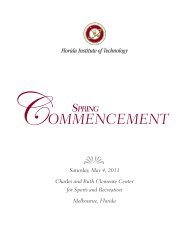2006–2007 - Florida Institute of Technology
2006–2007 - Florida Institute of Technology
2006–2007 - Florida Institute of Technology
You also want an ePaper? Increase the reach of your titles
YUMPU automatically turns print PDFs into web optimized ePapers that Google loves.
Admission Requirements<br />
A candidate for the doctoral program in aerospace engineering<br />
will normally have completed a master’s degree in aerospace or<br />
mechanical engineering and have adequate preparation in areas<br />
<strong>of</strong> fundamental science and mathematics. Alternatively, a student<br />
enrolled in the master’s program may apply to work directly<br />
toward the doctoral degree after completing at least 18 credit<br />
hours <strong>of</strong> graduate course work at <strong>Florida</strong> Tech with a cumulative<br />
grade point average <strong>of</strong> at least 3.5.<br />
Doctoral applicants should have superior academic records,<br />
provide letters <strong>of</strong> recommendation and take the Graduate Record<br />
Examination General Test.<br />
General admission requirements and the process for applying are<br />
presented in the Graduate Information and Regulations section <strong>of</strong><br />
this catalog.<br />
Degree Requirements<br />
The degree <strong>of</strong> doctor <strong>of</strong> philosophy is conferred primarily in<br />
recognition <strong>of</strong> creative accomplishment and the ability to investigate<br />
scientific or engineering problems independently, rather than<br />
for completion <strong>of</strong> a definite curriculum. The program consists<br />
<strong>of</strong> advanced studies and research leading to a significant contribution<br />
to the knowledge <strong>of</strong> a particular problem. A student’s<br />
research may have analytical, computational or experimental<br />
components, or some combination <strong>of</strong> these. Each student is<br />
expected to complete an approved program <strong>of</strong> study beyond that<br />
required for a master’s degree, pass the comprehensive examination<br />
(both written and oral parts), present a dissertation proposal<br />
acceptable to the student’s committee, complete a program <strong>of</strong><br />
significant original research, and prepare and defend a dissertation<br />
detailing the research work.<br />
The program consists <strong>of</strong> 90 credit hours <strong>of</strong> study beyond the<br />
bachelor’s degree or 60 credit hours beyond the master’s degree.<br />
Candidates from both the thesis and nonthesis master’s programs<br />
may be admitted into the doctoral program. However, students<br />
from the second category must have demonstrated exceptional<br />
potential for advanced study to be admitted. Of the 90 credit<br />
hours, 36 shall be for dissertation registration, although six credit<br />
hours <strong>of</strong> successfully completed master’s thesis registration will<br />
normally be accepted into this category.<br />
The purpose <strong>of</strong> the comprehensive examination is to cover the<br />
student’s major field <strong>of</strong> study and related fields important to the<br />
major field. The examination is given when, in the judgment <strong>of</strong><br />
the student’s advisory committee, the student has had sufficient<br />
preparation in his/her field <strong>of</strong> study by completing significant<br />
course work in at least three areas <strong>of</strong> specialization, as well as<br />
in mathematics, and by initiating doctoral research. The examination<br />
must normally be taken before the end <strong>of</strong> the student’s<br />
fourth academic semester after admission into the doctoral<br />
program. The written portion <strong>of</strong> the examination consists <strong>of</strong><br />
individual parts given by each member <strong>of</strong> the advisory committee.<br />
These written examinations are intended to cover each <strong>of</strong> the<br />
student’s areas <strong>of</strong> specialization and applied mathematics. The<br />
written portion <strong>of</strong> the comprehensive examination is followed<br />
by an oral component that provides the advisory committee an<br />
opportunity to complete the examinations in each <strong>of</strong> the student’s<br />
areas <strong>of</strong> study. Subsequent to completion <strong>of</strong> both written and oral<br />
components <strong>of</strong> the comprehensive examination, a dissertation<br />
proposal must be submitted to the student’s advisory committee<br />
for evaluation. Upon determining that the proposed research is<br />
<strong>of</strong> doctoral quality and that completion is feasible, the student is<br />
advanced to candidacy for the doctoral degree.<br />
General degree requirements are presented in the Graduate<br />
Information and Regulations section <strong>of</strong> this catalog.<br />
Curriculum<br />
The doctoral program <strong>of</strong> study must be approved by the student’s<br />
advisory committee and the department head. Considerable<br />
latitude is allowable in course selection, although appropriate<br />
advanced courses are expected to form a part <strong>of</strong> the student’s program.<br />
A representative distribution <strong>of</strong> these courses taken beyond<br />
the bachelor’s degree should include, as a minimum, five courses<br />
in the major area and four, three and three courses (in any combination)<br />
in the two related areas and mathematics. These choices<br />
provide for the selection <strong>of</strong> three additional courses as electives.<br />
The following illustrates a representative doctoral program <strong>of</strong><br />
study beyond the bachelor’s degree.<br />
Major Area (Specialization) ....................................................................15<br />
Two Related Areas (Specializations) and Mathematics ..........................30<br />
Electives ....................................................................................................9<br />
Dissertation (includes 6 credit hours thesis, if completed) .....................36<br />
TOTAL CREDITS REQUIRED 90<br />
Selected course <strong>of</strong>ferings from other engineering and science<br />
programs can be taken to fulfill the elective requirements. Each<br />
student takes electives from the course listings and from mathematics<br />
based on his or her areas <strong>of</strong> interest and in consultation<br />
with his or her committee.<br />
Research Activities and Facilities<br />
The research facilities <strong>of</strong> the aerospace engineering program<br />
include laboratories in energy research, fluid mechanics and<br />
aerodynamics, combustion and propulsion, metallurgy and solid<br />
mechanics, system dynamics and control, instrumentation and<br />
applied laser research, computer-aided design and computational<br />
research. Other laboratories around the campus can also be used<br />
by aerospace engineering graduate students performing advanced<br />
research.<br />
Funded research activities <strong>of</strong> the aerospace and mechanical engineering<br />
faculty have included studies <strong>of</strong> efficient heat transfer<br />
and insulation mechanisms in building environments; combustion<br />
in porous media; advanced heating, ventilation and airconditioning;<br />
fuel systems; computations <strong>of</strong> radiative transport;<br />
computational mechanics with emphasis on damage mechanisms<br />
in laminated composite structures; crashworthiness <strong>of</strong> aircraft<br />
structures; computation <strong>of</strong> flows in turbine blade environments;<br />
turbulent boundary-layer structure with flexible roughness;<br />
experimental studies <strong>of</strong> pressure- and/or temperature-sensitive<br />
paints; material characterization using CW and short-pulse<br />
lasers; analysis and computation <strong>of</strong> natural convection; study <strong>of</strong><br />
leaks in cryogenic seals; and turbulent transport <strong>of</strong> moisture contained<br />
in air streams. Other studies have involved convection and<br />
diffusion <strong>of</strong> radon gas in porous media, smart composite structures<br />
with embedded sensors and optimization <strong>of</strong> composites.<br />
Laboratories include the Fluid Dynamics Laboratory and<br />
the Aerospace Structures Laboratory. The Fluid Dynamics<br />
Laboratory features a low-speed, low-turbulence wind tunnel <strong>of</strong><br />
open-return type, with a square test section 0.535 m on a side<br />
and 1.6 m long. The speed range is from zero to 42 m/s. The<br />
mean turbulence level is a few hundredths <strong>of</strong> 1 percent at the<br />
College <strong>of</strong> Engineering–Aerospace Engineering<br />
55



